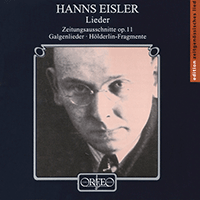
Hanns Eisler (1898 - 1962)
Hanns Eisler was born into a liberal middle-class family, which moved in 1901 from Leipzig to Vienna. Here he studied music from books and scores, the family having insufficient money to buy a piano. He served in a Hungarian regiment during the last two years of World War I, and subsequently enrolled as a student at the New Vienna Conservatory. Soon Eisler moved on to become a pupil of Schoenberg, who was instrumental in the publication and public performance of his Piano Sonata Op. 1, which won the Vienna Arts Prize, and then during 1925 he settled in Berlin in order to take up a teaching post at the Klindworth-Scharwenka Conservatory, joining the German Communist party the following year.
He soon broke with Schoenberg (for whom however he retained the greatest respect throughout the rest of his life) and began to compose music, such as his popular marching songs, which had an overtly political purpose. Eisler started to collaborate with Bertolt Brecht in 1930, writing music for Brecht’s plays that comments upon rather than illustrates the meaning of the lyrics; he also visited Russia twice and was involved in the production of the film Kuhle Wampe. The rise to power of Hitler in 1933 stopped Eisler’s career in Germany in its tracks: his music was banned, and he spent the next fifteen years in exile, composing music dedicated to the overthrow of Fascism.
After visiting many European countries, Eisler returned to the USA, which he had previously visited twice, to take up a post at the New School for Social Research in New York. Following a period in Mexico and time spent researching film music, he moved to Hollywood in 1942 to teach at the University of Southern California and was reunited with Brecht. While in California he composed several film scores and chamber works, as well as the music for many poems by Brecht on the topic of exile. Because of his pronounced political views, together with other Hollywood figures he was called before the Committee on Un-American Activities and was expelled from the USA in 1948. After visits to Berlin, Vienna, and Prague he settled in Berlin in 1949, where he took up a professorship at the Berlin High School for Music and was elected to the German Academy of Arts in 1950.
For the remainder of his life Eisler lived within the social system of the German Democratic Republic (DDR or East Germany). In Berlin he composed what he termed ‘applied music’, for use in locations such as the theatre, cinema, television and public events. Above all he sought to compose in ‘…an idiom that could be immediately understood and quickly learnt’ (David Blake). Despite limitations of time and individual circumstance much of Eisler’s music is of a very high standard: of particular interest are his cantata Die Mutter, and the Deutsche Symphonie, Op. 50. The state apparatus within which he worked at the end of his life viewed cultural activity, and by extension sound recording, as a legitimate part of its social policy, and so through the East German recording company Deutsche Schallplatten and its consumer label Eterna, several recordings were made of him conducting his own music.
Like his compositions, Eisler as an executant musician was direct and technically secure. Action is suited to the moment. Among the few but notable recordings left by him as a conductor are performances from before World War II of several of his songs in which he accompanied the famous actor and singer Ernst Busch. Post-war recordings included works such as Die Tage der Kommune and Die Teppichweber von Kujan-Bulak, as well as extracts from the cantata Mitte des Jahrhunderts, and the Klingende Dokumente III. During his time in America he also conducted the music that he had composed to accompany a recording of Charles Dickens’s Mr Pickwick’s Christmas, narrated by Charles Laughton.
© Naxos Rights International Ltd. — David Patmore (A–Z of Conductors, Naxos 8.558087–90).
















